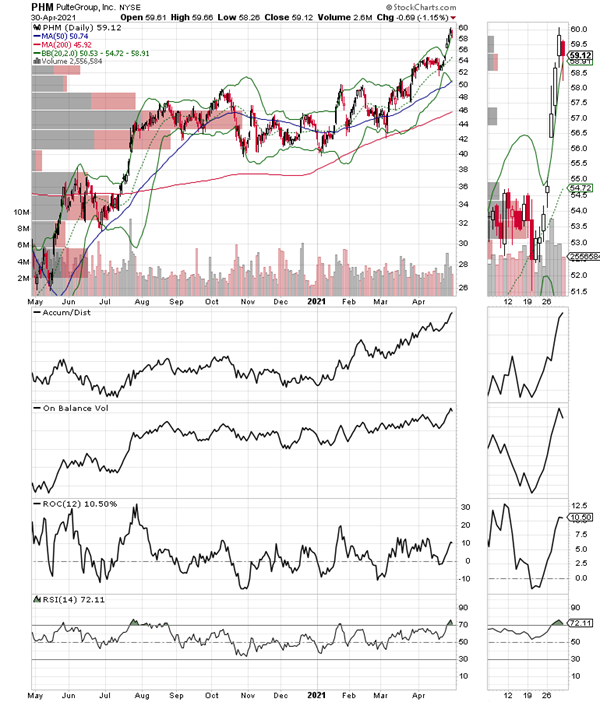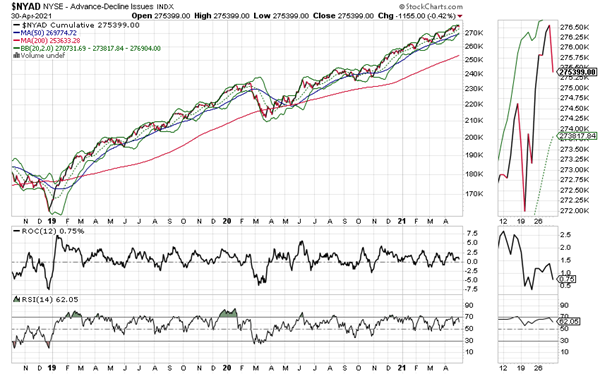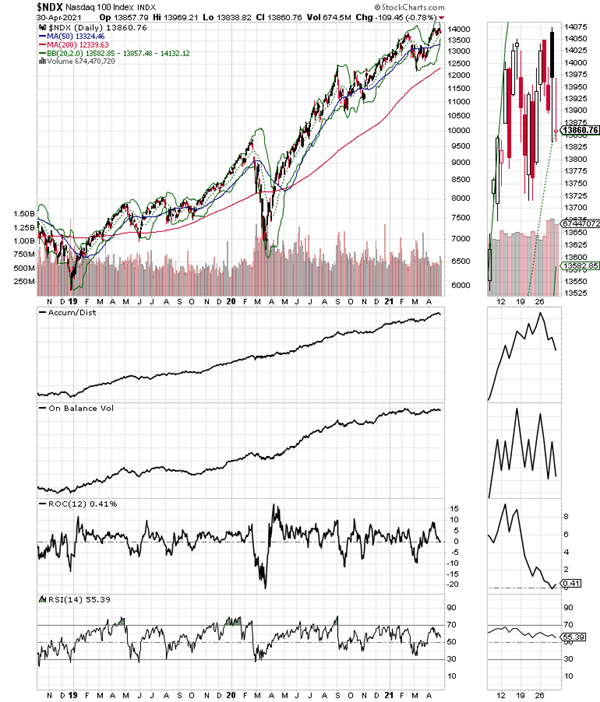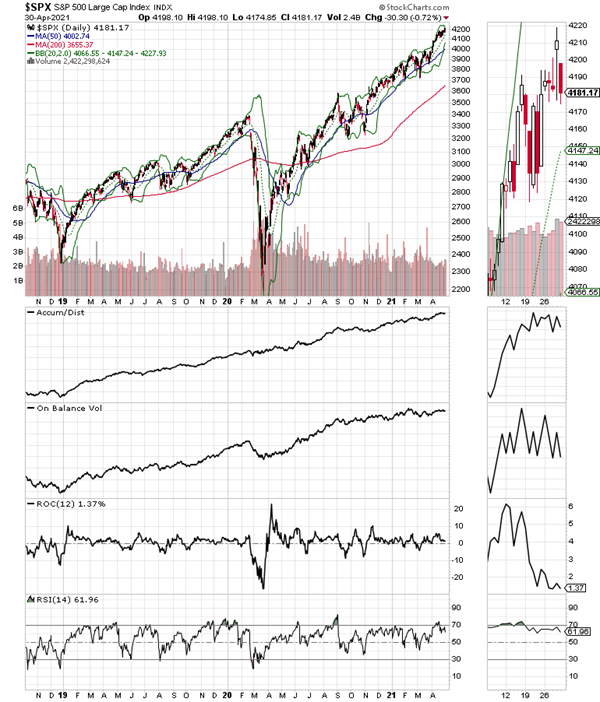Stocks look a bit sluggish all of a sudden as rising COVID problems in India and hints that the Fed may slow its money printing presses have made traders uneasy, states Joe Duarte of In the Money Options.
Yet the key to the uptrend remains how serious the algos take the Fed, which means that if the central bank doesn’t talk about raising rates much, the algos with their ultra-nanosecond memory and attention span won’t pay attention and the odds will continue to favor higher stock prices.
Nevertheless, the “sell in May” mantra is beginning to appear here and there and with the stock market near all-time highs and a great deal of “good news” priced in, a plausible next step for equities is at least a slowing of the advance and perhaps even some sort of pullback or consolidation. That said, the odds of a market crash remain low due to the high level of worry that is obvious. This is based on the potential for higher taxes, the likelihood of continuing supply chain constraints and the persistence of COVID-19 problems around the world.
Still, no matter what, the fly in the ointment remains the Fed and how the algos take what the Fed says. So be ready to throw out any positives if the central bank starts to rumble more loudly about raising interest rates.
This should be taken seriously since at least one Fed president is starting to jawbone for rate hikes, which means that if others join the chorus, then the odds of a very nasty turn lower for stocks will increase. And make no mistake about it, when the market turns lower it will do so aggressively as the algos will turn to selling stock index futures and selling stocks short in a hurry.
Nevertheless, barring a complete loss of reason from the Fed, the current mixed economic scenario translates into one in which the central bank is not likely to raise interest rates any time soon, a fact that is likely to keep a floor under stocks.
The bottom line at this point, no matter the environment, is that focusing on individual portfolio positions remains the dominant aspect of trading success. All of which means that selectivity and risk management are at the top of the portfolio to do list.
Persistent Put Buyers Put Damper on Rally as Negative Fed Headlines Trigger Algos
We saw a perfect example of the coupling of negative headlines and the activity of the options markets last week with the net effect being negative for stock prices with the net effect being increasing volatility between the 415 and 420 strike prices on SPY.
The three options expirations (M, W, F) for the SPDR S&P 500 ETF (SPY) last week were mixed as put buyers emerged on Thursday at the 419 strike price, which caused the dealers to sell puts and sell stocks and stock index futures short to hedge. Interestingly, call buyers were numerous at 420 in much higher volume but the put buyers prevailed as SPY rallied to 420 on Thursday afternoon but didn’t break above the key resistance level for long.
Moreover, when the echoes of Dallas Fed President Kaplan talking about bond purchase tapering in 2022 resurfaced, the put buyers crawled out of their holes and attacked the 417 strike price for the expiring SPY options sending stocks lower on Friday.
Here is what happens in the options market. When call buyers force dealers to hedge their call option sales via stock and stock index futures purchases stocks tend to rise, as we saw on Friday. In contrast, on Thursday, put buyers forced dealers to sell puts and then hedge their bets by selling stocks and selling index futures to hedge. The bottom line is that the options market, specifically weekly expirations on SPY continue to exert a credible influence on the overall stock market.
Pulte Pulls Away from the Pack Even After Missing on Revenues
Why did the shares of Pulte Homes (PHM) break out after a recent revenue miss?
Everyone is familiar with the fact that homebuilders remain in a good position due to relatively low interest rates, the continuing migration from big cities, and the persistently low supply of homes available in the market. This is further detailed by PHM CEO Ryan H. Marshall’s opening comments during the company’s recent earnings call: “The US housing market is 3.8 million single family home short of what is needed to meet the country's demand according to a new analysis by mortgage-finance company Freddie Mac. The estimate represents a 52% rise in the nation's home shortage compared with 2018, the first-time Freddie Mac quantified the shortfall.” Specifically, he noted that since the supply problem has been years in the making it will likely take years to correct, which puts homebuilders in an excellent secular position, barring of course the inevitable unforeseen events such as the Fed hiking interest rates and so forth.

Much of the stock’s recent rise may have to do with the way PHM is running its business. Chiefly, they now have more land on option than the land they own outright, a dynamic which cuts costs and helps to raise margins and improve both cash flow as well as giving the company more flexibility in running operations. They are also targeting specific demographics such as the rising empty nesters who are looking to move to all-inclusive communities with amenities such as Pulte’s Del Webb developments. Moreover, orders in all segments are rising and they are selling more units at higher average prices—$430,000. And there is no future shortage of business with an $8.8 billion order backlog and a 31% increase in orders during the quarter. In addition, they are cutting discounting, accelerating production, and increasing deliveries while demand rises and supply remains constrained.
So, here is where it gets interesting: PHM missed on revenues and the stock broke out and moved decidedly higher. This is a sign of strength in the shares and suggests investor confidence in the company’s management, which is firing on all cylinders. In addition, it’s likely the rally erupted because of a very positive outlook, which includes expectations for 20+% growth gains per quarter for the rest of 2021.
Meanwhile, the stock is well into a price breakout and remains under aggressive accumulation as both Accumulation Distribution (ADI) and On-Balance Volume (OBV) are rising rapildy. Moreover, its Volume by Price (VBP) activity suggests good support at $55-$60. PHM is overbought at the moment, but I expect a consolidation as the most likely scenario, which means that over the next few weeks there may be an opportunity to add to the position.
I have a position in PHM as of this writing.
NYAD Makes More New Highs Confirmed by SPX, NDX
Even though we had some interim weakness last week, the New York Stock Exchange Advance Decline line (NYAD) continued its recent ramp up with another new high to close out the week, which means the trend for stocks remains up.
NYAD Rolls Over on Friday as the Fed Spooked Stock Traders
The New York Stock Exchange Advance Decline line (NYAD) cruised along most of last week but stumbled on Friday. Still, it remains in an uptrend and gets the benefit of the doubt for now as it remained above its 20-day moving average, meaning it’s still in a short-term up trend.

Moreover, as long as NYAD continues to make new highs, remains above its 50- and 200-day moving averages and its corresponding RSI reading remains above 50, the trend remains up. This combined set of observations has been extremely reliable since 2016 and shows no signs of becoming unreliable as of this writing.

The Nasdaq 100 index (NDX), is increasingly weak, as it mini-crashed to its 20-day moving average on Friday. However, the support level is misleading as the RSI is near 50 for NDX, which suggests a fairly sizeable loss of momentum. This type of picture is more bearish than bullish for tech stocks over the next few days to weeks.

The S&P 500 (SPX) is struggling to get above 4220 and support is 4000 to 4150. The index remains above its 20-, 50-, and 200-day moving averages.
To learn more about Joe Duarte, please visit JoeDuarteintheMoneyOptions.com.





















